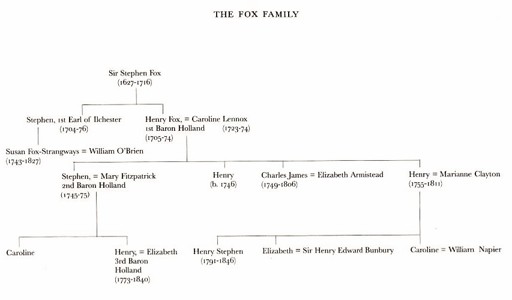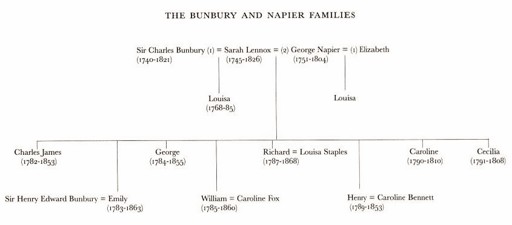Aristocrats (67 page)

Part Three
Travellers’ impressions of Naples and Sir William Hamilton are described in Flora Fraser,
Beloved Emma, The Life of Emma Lady Hamilton
, 1986. The Duc de Lauzun’s claims to have been Sarah’s lover are made in
Memoirs of the Duc de Lauzun
, trans. C. K. Scott-Moncrieff, 1928.
Chapter Four
Part One
Town and Country Magazine
, April and August 1769, and the
London Chronicle
both carried details of Sarah’s elopement. E. R. Curtis deals with the affair in great detail in
Lady Sarah Lennox. An Irrepressible Stuart 1745–1826
, 1947. The testimonies of Bunbury’s servants are quoted from the records of the Consistory Court of the Bishops of London Depositions books. Laurence Stone’s
Road to Divorce. England 1530–1987
, 1990, describes the relationships between suits for criminal conversation, separations and parliamentary divorce. The
Journal of the House of Lords
prints the evidence against Sarah and the Act granting Bunbury a divorce in the journals for 1776. Lady Mary Coke’s
gossip is from
The Letters and Journals of Lady Mary Coke
, 4 vol., 1889–96.
Part Two
Mrs Delany’s letter about the marriage of Ogilvie and Emily is from Lady Llanover ed.,
Autobiography and Correspondence of Mary Granville, Mrs Delany, 6 vol
., 1861–2. Gossip about Ogilvie’s antecedents and early career is found twice in
The Farington Diary, by Joseph Farington, R. A
., ed. James Greig, 1922–28. Charlotte Fitzgerald’s diary is quoted in Hon. Charles P. Strutt,
The Strutt Family of Terling 1650–1873
, 1939.
Chapter Five
Part One
The White’s Hotel dinner and Tom Paine’s sojourn in Paris were written up in the following newspapers:
Dublin Evening Post, 6
Dec 1792,
The Annual Register
for 1792,
London Chronicle
, Dec 1792,
The World
, Dec 1792. For Paine and other English
émigrés
in Paris see Audrey Williamson,
Thomas Paine; his Life, Work and Times
, 1973; Eric Foner,
Tom Paine and Revolutionary America
, 1976; J. G. Alger,
Englishmen in the French Revolution
, 1889.
Amongst the corpus of literature devoted to the Napier brothers I have made particular use of the following: Stephen Gwynn,
A Brotherhood of Heroes. Being Memorials of Charles, George and William Napier
, 1910; General W. E. Napier ed.,
Passages in the Early Military Life of General Sir George T. Napier KCB, written by Himself
, 1884; Lieutenant-General Sir William Napier, KCB,
The Life and Opinions of Sir Charles James Napier
, 4 vol., 1857; H. A. Bruce, MP,
The Life of Sir William Napier
, 2 vol., 1864; C. J. Napier,
An Essay on the Present State of Ireland
, 1839; Rosamund Lawrence,
Charles Napier, Friend and Fighter 1782–1853
, 1952. Priscilla Napier’s
The Sword Dance. Lady Sarah Lennox and the Napiers
, 1971, tells Sarah’s story as part of the Napier family history.
Charles James Fox’s brief period in office is described in John Cannon,
The Fox-North Coalition: Crisis of the Constitution, 1782–4
, 1969. Leslie Mitchell’s
Charles James Fox
, 1992, discusses Fox’s attitudes to the French Revolution and Republic. Fox’s marriage and death are related in I. M. Davis,
The Harlot and the Statesman
, c.1986.
Part Two
No account of the Irish Rebellion could be told
without Thomas Pakenham’s classic
The Year of Liberty. The Story of the Great Irish Rebellion of
1798, 1969. Marianne Elliott’s
Wolfe Tone, Prophet of Irish Independence
, 1989, and
Partners in Revolution: the United Irishmen and France
, 1982, was similarly indispensable in clearing a way through the Irish underground of the 1790s. David Dickson’s
New Foundations: Ireland 1600–1800
, 1987, takes the story up to the point of Union. Anthony Malcolmson brought to my attention an anonymous pamphlet,
Protestant Ascendancy and Catholic Emancipation Reconciled by a Legislative Union
, published by a radical London printer in 1800 and rumoured to be by William Ogilvie. The pamphlet argues that the Union is in the best interests of Catholics because they will only achieve emancipation with the help of radicals at Westminster. There is no reference to the pamphlet in any family correspondence, nothing to confirm or deny that Ogilvie was its author. Its view is consistent with that taken by the Napiers and some English Whigs.
Several lives of Lord Edward Fitzgerald print letters and extracts from diaries that have since been lost. The earliest is Thomas Moore’s
The Life and Death of Lord Edward Fitzgerald
, 2 vol., 1831. Moore seems to have been given free access to letters and papers in the hands of Mimi Beauclerk, which are now lost. These seem to have included many letters from Edward to Emily, letters from Emily to Mimi and perhaps to other friends, and a good deal of misc. material. Gerald Campbell’s
Edward and Pamela Fitzgerald
, 1904, prints extracts from diaries and letters written by Lucy Fitzgerald that I have been unable to trace.
Part Three
The Marlay Letters, 1718–1820
, 1937, ed. R. Warwick Bond, a selection of correspondence to members of the Charleville family, includes letters from Louisa and Sarah about the deaths of both Napier and Conolly, as well as letters from Sarah about the monarch and her efforts to get a pension. Linda Colley’s
Britons: Forging the Nation, 1707–1837
, 1992, points up the increasingly conservative and militaristic views held by many in the two decades after the French Revolution. Finally, Marmontel’s
Memoirs
were published in 1805.
Note on the Leinster Papers, National Library of Ireland
At first sight this huge collection looks like a coherent archive, an ‘autobiography’ of sorts, put together and frequently annoted by Emily as a record of her life. There are gaps, most notably in the years between 1769 and 1774. But these are easily explicable; Emily, like Caroline, could have destroyed all the papers that referred to the Fox–Leinster quarrels of 1769 and with them all reference to Sarah’s elopement and the death of the first Duke of Leinster. The collection, with the exception of the series between Emily and William Ogilvie, more or less comes to a halt in 1794, and thus appears to have been separated from what must have been an equally bulky second part, covering the years between 1794 and Emily’s death in 1814.
When we consider what is
not
in the collection, however, doubts begin to surface about its shape being determined by either Emily’s own ‘editing’ or by simple loss. We know that the second half of the collection (or at least some of it) survived until the 1830s; Thomas Moore, biographer of Edward Fitzgerald, printed in his biography of 1831 both letters that are now in the NLI and letters from post-1794 that are now lost. Thus neither Emily nor Ogilvie (who left the family papers to his daughter Mimi Beauclerk) separated the parts.
Two other doubts arise. The first is that there are no letters in the archive from any male members of the Fox–Lennox family: Henry Fox, the third Duke of Richmond, Lord George Lennox, and most surprisingly, Charles James Fox. Indeed, there is no specifically ‘political’ correspondence at all. In their insistence on sisters, husbands and children the Leinster Papers seem the mirror image of the Holland House Papers.
Secondly, 1794 as a cut-off date for the collection could be seen, in the light of the above, to be anything but arbitrary. With the Terror reaching its bloody conclusion in Paris and Foxites like Emily and Lord Edward Fitzgerald who had walked an ideological tightrope between Francophilia and loyalty to the British Crown under great pressure, the family correspondence must have been tense and anxious and can only have become more
so as Edward Fitzgerald went underground and the rebellion in Ireland approached.
Taking all this into account, it is possible that the letters post-1794, together with other political material, were removed. A collector interested in politics might have taken out this material and abandoned the rest, discarding all the letters now in the NLI as domestic and trivial. Alternatively a family member may, after 1830, have sifted through the whole collection and produced a new version of Emily’s life, eliminating everything politically or morally compromising. At any rate it seems fairly clear that after the deaths of Emily and Ogilvie the collection shrank. Although both hand and motive remain obscure, its shrinkage seems too considered to be simple ‘natural wastage’.




Published by Vintage 1995
Copyright © Stella Tillyard 1994
All rights reserved.
The right of Stella Tillyard to be identified as the author of this work has been asserted by her in accordance with the Copyright, Designs and Patents Act, 1988
First published in Great Britain by
Chatto & Windus Ltd, 1994
Vintage
Random House, 20 Vauxhall Bridge Road, London SW1V 2SA
Random House Australia (Pty) Limited
20 Alfred Street, Milsons Point, Sydney
New South Wales 2061, Australia
Random House New Zealand Limited
18 Poland Road, Glenfield,
Auckland 10, New Zealand
Random House South Africa (Pty) Limited
P.O. Box 337, Bergvlei, South Africa
Random House UK Limited Reg. No. 954009
A CIP catalogue record for this book is available from the British Library
ISBN: 0099592614
Epub ISBN: 978-1446498125
Version 1.0
